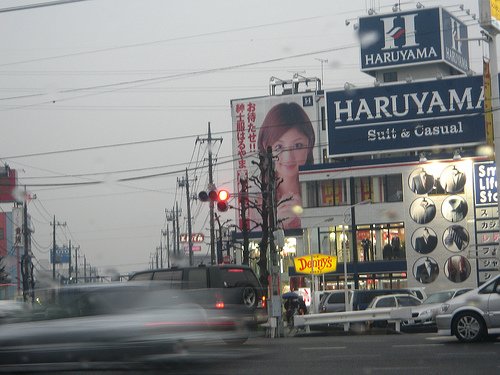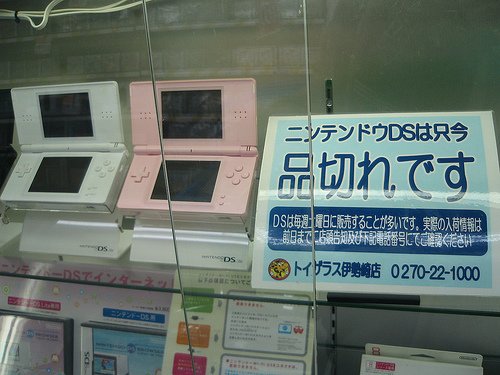I caught a post on Slashdot the other day about a surge in high school dropouts in the U.S., and was saddened at the news. In Japan, compulsory education covers six years of elementary school and three years of junior high school, and during that time the basics that everyone needs to know are taught — math, social studies, kanji, morals, learning to respect your senpai, and so on. High school has never been required, and there’s nothing keeping a sixteen year old who has something better to do with his time from not going on past the 9th year of school. Just the same, there’s a heavy stigma — the dreaded label chu-sotsu (中卒) meaning a graduate of junior high school — against anyone who doesn’t make it through high school, and the vast majority of students (96%) do go on. High schools in Japan function as a miniature version of the university system complete with entrance exams, and competition for the best schools — Takasaki High and Maebashi Girl’s School are the highest- ranked in our prefecture — is fierce, requiring years of preparation to get in. Just as with universities, it’s possible for students to aim too high and fail all their tests, and become a ronin, a word which used to mean masterless samurai but which now refers to a student who is in temporary limbo while he prepares for next year’s tests.
When Japanese people go to the U.S. they’re amazed at the variety of foods available in supermarkets, especially the staggering number of breakfast cereals. “In SAFEWAY, many kinds of corn flakes about one hundred have overpowered me,” one of my former ESL students wrote at the time. “I felt a difference of the staple foods.” In Japan, gaijin might say the same about the instant ramen, with supermarkets and convenience stores brimming with various brands of noodles in every shape, size, and taste. Instant ramen came into being in 1958 with the introduction of Chicken Ramen by Nissin, and the convenience of noodles that could be stored easily and eaten anytime made them an instant hit, if you’ll forgive the pun. Today many large companies compete to bring the best noodle products to market, including such favorites as Nissin’s popular Cup Ramen line, the delicious Akai Kitsune Udon (“Red Fox” noodles with fried tofu in each package, yum), and even high-end brands that cost $5 or more per serving. Some numbers for you: Japan eats 5.4 billion servings of instant noodles per year (42 per person on average), the amount of flour used to make this ramen would fill up half of Tokyo Dome, and there are 983 registered brands of instant noodles on the market. I can personally attest to the profitability of instant ramen. During my ESL days, I happened to teach English to the wife of the former president of the Sapporo Ichiban Company, and her house was easily the most beautiful building I’ve seen outside of Kyoto. Instead of learning any English, we’d often sit in her unspeakably gorgeous tatami room speaking Japanese, drinking green tea and eating delicious manju cakes. This is basically the holy grail of ESL teaching, to find rich people and get them to pay you while they teach you Japanese rather than the other way around.
The other night I went downstairs to my parents liquor shop to get something — the Japanese custom of building shops and homes together can be quite convenient when you run out of soy sauce or coffee filters or beer, since you’ve usually got what you need right there in the store. My wife’s father and mother were watching a jidai geki, or a historical drama, in this case about the years leading up to the Battle of Sekigahara, where Ieyasu Tokugawa finally defeated his enemies and unified the country under his shogun banner. They were having a very deep discussion about the actions of the main character, an underling of Tokugawa, and how he narrowly saved the day for his lord. Like Westerns back in the 1950’s, samurai period dramas are a popular genre of television, with many different shows produced for all ages. The most famous jidai geki on TV is the megabudget Taiga Drama that NHK produced each year, telling dramatic stories from a different part of Japan’s past. Perhaps it has to do with higher average age of Japanese people, but it seems they have a lot more interest in their history than folks from the States could ever conceive of, and even younger people like my wife can take quite an active interest in events 400 or more years ago.
J-List carries hundreds of delicious and fun to eat snack items from Japan, including Pocky & Pretz, Pucca chocolate-filled fish-shaped pretzels, candy sushi, and unique varieties of Kit Kat only sold in Japan. Today we’re posting this year’s first Melty Kiss, the yummy fudge cubes from Meiji that are not only delicious, they’ve got one of the strangest names of any product we sell. This year’s Melty Kiss is excellent, with the delicate taste of cocoa powder on the outside and rich fudge on the inside. Look for Precious Cacao and Strawberry on the site now.
















